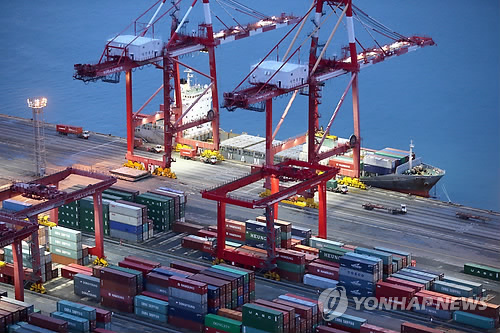Korea faces an increasing need to ensure a balance between exports and domestic demand, which is crucial for the sustainable growth of its economy, economists say.
They note changes in global economic conditions make the need more urgent but government policymakers are not yet fully up to the task.
The country’s outbound shipments fell for the 17th consecutive month in May, though the pace of decline decelerated from the preceding months.
The National Assembly Budget Office said in a report released Monday that Korea’s slumping exports would reduce its growth by 0.2 percentage points this year. In 2015, the country saw declining exports cut its growth by 1.1 percentage points.
Korean manufacturing exporters’ heavy dependence on a limited number of traditional export items and China have put them in a more vulnerable position than foreign competitors.
Trade officials here have been going all-out in implementing measures to increase exports. This export-focused endeavor, however, may be off the path the country should take for its long-term, steadfast growth, experts say.
There will inevitably be a limit to such efforts as major economies have leaned toward trade protectionism to keep their jobs amid supply gluts across the world since the 2008 global financial crisis.
Reliance on exports for growth will also put Korea under greater pressure from countries that have a widening trade imbalance with it, in particular the U.S.
Some economic commentators here argue Seoul should view the increasing U.S. pressure on Korea to alter its trade and currency practices as signaling its traditional path to growth will be unviable. They took note of U.S. Treasury Secretary Jack Lew holding an unusual meeting with the Bank of Korea governor during his recent visit here to caution against Seoul’s one-sided intervention in the currency market.
Despite the downward trend in its exports, Korea saw its trade surplus with the U.S. soaring to $28.3 billion last year from $15.2 billion in 2012, when a bilateral free trade deal took effect. Washington has cast a dubious eye on the depreciation of won against the dollar as a factor behind the widening trade imbalance.
The ratio of Korea’s exports to gross domestic product, which amounted to nearly 60 percent three years ago, still hovers above 50 percent.
In this economic structure, boosting exports is essential for revitalizing Korea’s sluggish economy. But even a limited success in increasing outbound shipments would result in expanding the country’s current account surplus, which surpasses 7 percent of GDP, far higher than a proper level suggested by the U.S. at 3 percent.
Economists say the government and business circles should now accelerate efforts toward overhauling the country’s industrial structure, based on a sense of urgency that remaining focused on the traditional manufacturing sector could not guarantee its economic survival, let alone growth.
Since the early 2000s, efforts have been made to rebalance the economy by easing regulations and upgrading the service industry. Shortly after winning the 2012 presidential election, President Park Geun-hye pledged to shift the economy from dependence on big manufacturing exporters to a parallel growth between large and small companies and between exports and domestic demand.
The reality, however, is that the proportion of private consumption in GDP went below 50 percent last year, marking the lowest level in 17 years.
According to data from the BOK, consumer spending contracted by 0.2 percentage points on-quarter in the first three months of this year. By contrast, savings rate rose by 1.8 percentage points to 36.2 percent over the cited period in a reflection of people’s growing anxiety over their post-retirement life and economic uncertainties.
As a result, the average household propensity to consume, which refers to the ratio of spending to disposable income, fell by 0.2 percentage points from a year earlier to 72.1 percent in the first quarter of the year, the lowest level since 2003. The consumption propensity, which peaked at 77.6 percent in 2010, continued to decline to 74.7 percent in 2012, 73.6 percent in 2014 and 72.4 percent in 2015, according to figures from Statistics Korea.
“The effect of measures taken by the government to boost spending has been short-lived,” said Hong Ki-seok, professor of economics at Ewha Womans University in Seoul.
Experts stress the need to address structural problems that have weakened household spending power, such as stagnant income, rising rent and education cost.
Data from the national statistics office showed the average real household income fell for the second consecutive quarter in the January-March period.
According to a local study, Korean households on average spend nearly a quarter of their monthly income to pay for housing costs, about 10 percent higher than Japanese households. The ever-rising rent is cited as a reason for the mounting household debt, which amounted to a record high of 1,223.7 trillion won ($1.05 trillion) at the end of March.
With their income stagnant, households still increased payments for children’s private tutoring last year.
Experts note easing structural burdens on household spending will also lead to helping raise the country’s birthrate that remains among the lowest in the world.
By Kim Kyung-ho (
khkim@heraldcorp.com)




![[Today’s K-pop] Blackpink’s Jennie, Lisa invited to Coachella as solo acts](http://res.heraldm.com/phpwas/restmb_idxmake.php?idx=644&simg=/content/image/2024/11/21/20241121050099_0.jpg)



